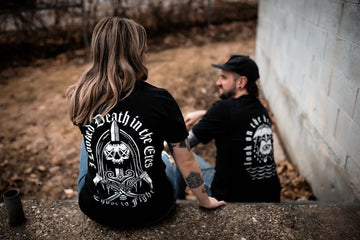There’s nothing quite like the excitement and satisfaction of a new tattoo. Walking around with fresh ink can make you feel like a million bucks. Until it doesn’t. Whether you’re a first time tatooee or a walking art display, experiencing symptoms that don’t feel quite right can be terrifying. You start thinking of worst-case scenarios. Like, what if your skin keeps peeling until you’re left with a patchy, half-there design? Or what if that little rash turns into a battle-like wound and you lose the whole limb?
We get it. Sketchy symptoms can cause a lot of stress. So how do you know what’s normal and what merits professional help?
Let’s compare normal post-tattoo symptoms to bad reactions.
What symptoms are normal?
Everyone’s body is going to react a little bit differently to a foreign substance being injected into their skin. Your skin type and your tattoo’s size and location can cause symptoms to vary. So, if you’ve gone under the needle before and are experiencing symptoms different from the first time, there’s no need for a full-fledged panic attack just yet. Typical reactions to a new tattoo can include:
- Redness and swelling that should subside within a few days
- Dull pain or discomfort that lasts a few days and can be managed with over-the-counter pain reliever
- Itching
- Mild flaking of the skin
- Temporary scarring
What can cause a bad reaction?
Photosensitivity: If your tattoo was exposed to sunlight before it was fully healed, those rays may cause an allergic reaction. Tattoos with red and yellow ink are especially prone to photosensitivity, so make sure you cover up before going outside while your tattoo is healing.
Acute inflammatory allergic reaction: Excessively red and swollen skin under and around your new tattoo may be a sign of an acute inflammatory allergic reaction. Caused by irritation from the tattoo needle and ink, this reaction is common and generally not cause for alarm. However, if it persists past two or three weeks, it’s a good idea to get it checked out.
Pseudolymphomatous allergic reaction: Yeah, it’s a mouthful. This allergic reaction is caused by irritation and sensitivity from substances in tattoo ink–particularly red, blue, or green hues. It may take a while for a pseudolymphomatus allergy to rear its head, so don’t be surprised if allergy symptoms start popping up a bit further into the healing process.
Lichenoid allergic reaction: Typically caused by red ink, this rare reaction makes itself known with little bumps that pop up anywhere red ink is present.
Dermatitis: Allergic contact and photoallergic contact are common forms of dermatitis, which are usually caused by mercury sulfide. This allergic reaction is typically caused by red ink.
Granulomas: Granulomas are small bumps that appear under and around tattoos that feature colored ink. Once again, red ink is the biggest culprit in causing granulomas, but they can also show up anywhere colored ink is present.
What are the telltale signs of a bad reaction?
- Persistent swelling and redness
- Excessive discomfort or pain
- Rashes or bumps
- Prolonged irritation and itching
- Long-lasting heat
- Changes in skin texture
- Fever and chills
- Discharge or oozing
- Lack of improvement
- Blisters
- Excessive flaking or scales
- Red or purple nodules
How to properly care for your tattoo to avoid a bad reaction:
While some reactions to tattoos show up due to underlying sensitivities in the skin, others can be avoided or lessened with proper care. Talk to your tattoo artist during your consultation about any known skin sensitivities so that they can help you navigate the road to recovery. It’s also important to ask for their aftercare instructions and recommendations in advance. This way, you can purchase any products you might need and be ready when the big day arrives.
Hydration is a crucial part of tattoo prep and aftercare, so be sure to drink plenty of water in the weeks leading up to and following your appointment. This will allow your skin to be the healthiest it can be, ensuring a smoother recovery.
Speaking of water, avoid any situations where the tattooed area might be submerged in water, like a swim at the beach or soak in the hot tub. You’ll also want to avoid anything that might cause contact with other outside contaminants, like sand, dust, or even a lick from your dog. And while we’re talking about things to avoid, add sunlight to the list. Basically, try to keep the area covered with loose clothing as much as possible while your tattoo heals to avoid exposing it to outside contaminants. We know you’re just itching to show off your new ink, but give it a few weeks. In the meantime, our tattoo inspired hoodies and long sleeve tattoo t-shirts are perfect for keeping your artwork covered while still letting everyone know just what kind of tatted baddie you are.
Lastly, it’s critical to keep your new tattoo clean. Wash with an unscented antibacterial soap, pat it dry with a clean towel, and follow it up with a light coat of your artist’s recommended moisturizer.
Know When to Seek Help
Some reactions to a new tattoo are totally normal. After all, you’ve just injected a foreign substance into the largest organ of your body. However, if symptoms linger longer than a few days or you notice any of the not-so-normal reactions, consult your artist. They’ll know if there’s any cause for concern and will let you know if a visit to the doctor is necessary. Keep tabs on your symptoms and follow all aftercare instructions carefully, and you’ll give your skin the best chance to experience a smooth healing process.




